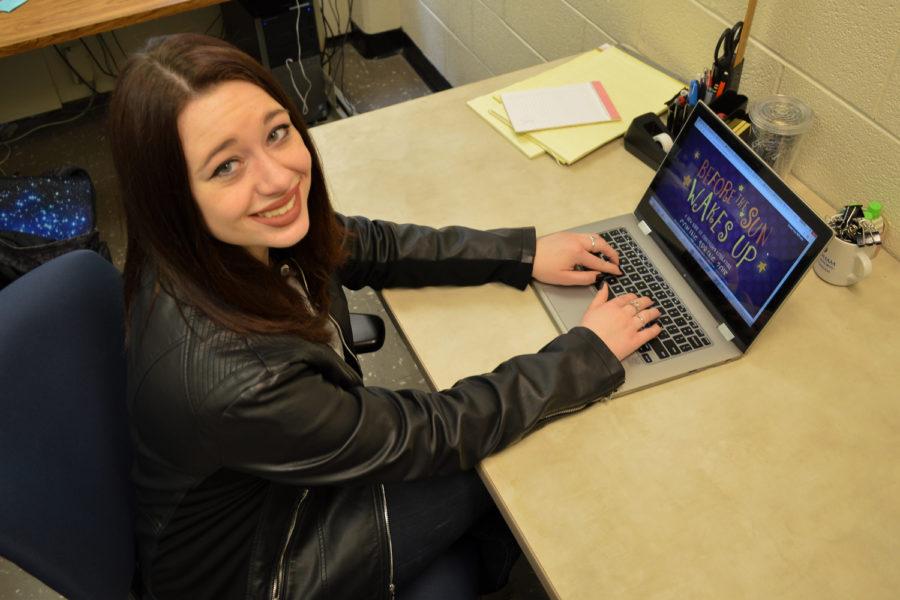Student-published children’s book promotes acceptance
Rachael Bindas, senior English writing major and gender sexuality and women’s studies minor, self-published her children’s book “Before the Sun Wakes Up” last April.
February 12, 2019
After reading a few children’s books to her 4-year-old sister to distract her from playing on a tablet, Pitt student Rachael Bindas figured she could write her own.
Fast-forward less than a year, Bindas self-published a children’s book, “Before the Sun Wakes Up,” in April 2018. The book aims to teach children acceptance regarding race and gender at a young age in a rhyming format they can enjoy.
A senior English writing major and a gender, sexuality and women’s studies minor, Bindas is also pursuing certificates in children’s literature and sustainability. But it was before declaring her children’s literature certificate that Bindas actually wrote the book in the summer of 2017.
“It really didn’t take that long. I wrote it originally as a poem that I knew I wanted to make into a book. I wanted to have a rhyme scheme for my intended audience — very young kids — trying to keep them engaged, and I figured a rhyme scheme would be good for that,” Bindas said. “So I wrote it just on a piece of paper as a poem knowing that each line of the poem would be broken up so it’s one line per page.”
The book tells the story of the sun waking up and the moon going to sleep at the start of a new day.
Bindas reached out to her close friend Alyssa Minko, a senior at Rochester Institute of Technology, to illustrate the book.
Because Bindas was determined to have Minko do the illustrations for her book, she realized self-publishing was the route to take, since publishing houses generally have illustrators on staff that they assign to their authors, Bindas said. Ultimately, the two just wanted “complete creative control” over the project.
Bindas said the narration is somewhat limited because it is only one line per page — a stylistic choice Bindas made to keep her young audience entertained and maintain the original poem’s rhyme scheme.
Due to the story’s structure, the illustrations serve an important purpose in the story’s implicit message. According to Bindas, she and Minko worked for months perfecting the illustrations to make sure they could reach a wide audience of children.
“We decided to take the main child character in the book and make the child gender-neutral … We didn’t want anything to indicate that this character was a boy or a girl. It’s a nameless child, it’s just meant to be a child that all children can look at and identify with,” Bindas said.
Bindas and Minko achieved gender neutrality through details like the colors surrounding the child character as well as what they were wearing, Bindas said. She and Minkas extended this theme of neutrality and acceptance to the character’s race.
“The same goes for race, we tried to make this child as racially ambiguous as possible. I know that’s impossible to do in entirety, but we really tried to make this child a representation of different races so that any child can look at this book and feel some sort of identification with the character,” Bindas said.
According to Bindas, this was important for the two of them to do, since many children’s books involve white children and rely on the gender binary.
Frayda Cohen, the director of undergraduate studies for the gender, sexuality and women’s studies program at Pitt, spoke with Bindas at a GSWS conference in April 2018. It was at this conference that Cohen and Bindas first talked in detail about the book.
“Her aim is to open up kids, very young kids’ awareness about issues pertaining to complex understandings of gender,” Cohen said. “So to familiarize them with people that they are already meeting in their everyday lives, but they’re not fully understanding maybe what trans is, what different kinds of gender identities there might be.”
Cohen was also impressed with how Bindas self-published her book, which she said takes a lot of work on behalf of the author.
Bindas herself can attest to the time commitment involved with getting a book self-published. In addition to the upfront cost Bindas addressed — which led her to create a Kickstarter to raise $1,500 — there are additional difficulties that come with marketing your own work.
“Independent publishing also means that you don’t have anyone acting as an agent for you. You do all that work for yourself. You have to collect as much publicity as possible, you have to advertise your book, you have to handle the marketing, et cetera,” Bindas said.
Even though “Before the Sun Wakes Up” was published in April 2018, Pitt’s children’s literature and GSWS programs are hosting a book launch on Wednesday. The event was originally scheduled for Jan. 30 but was moved due to the extreme temperatures. Copies of the book will be on sale during the event.
Courtney Weikle-Mills, a children’s literature professor at Pitt, is helping co-sponsor Wednesday’s event.
“We’re putting on the event because we’re proud of Rachael for creating and publishing a book,” Weikle-Mills said over email. “The book emerged out of practical circumstances — she has a little sister — but it’s also intellectually interesting in the sense that Rachael wanted it to appeal to and represent people with diverse gender identification and racial identity.”
Bindas hopes to use her platform at this event to talk about the issues her book addresses and why she felt she needed to do so.
“I really wanted to stress the importance of equality and acceptance,” Bindas said. “I don’t think anyone’s gender or race is a reason not to treat them as a full person and I want kids to learn that at a young age before they can even comprehend what it means to be of a certain race or what it means to be of a certain gender.”








